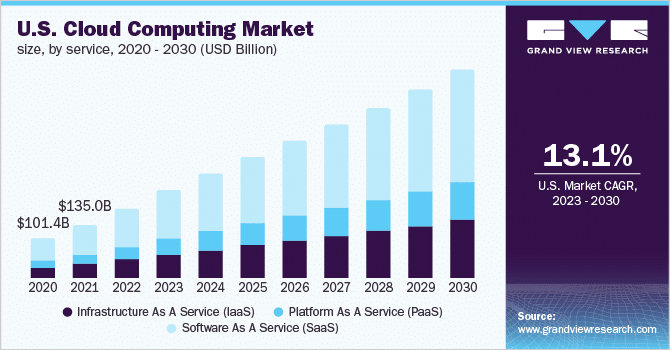The cloud migration process involves moving your digital assets, including data, applications, and infrastructure, to cloud-based environments. It’s a complex process that requires careful planning and execution to ensure that everything is transferred safely and securely.
In this guide, we’ll explore the different cloud migration steps and how a managed service provider (MSP) can help you complete your digital transformation with ease!
Understanding the Cloud Migration Process & its Benefits
You may be considering cloud migration to improve your organization’s scalability, agility, and cost-effectiveness – you’re not alone. Over 60% of all the world’s corporate data is now hosted in cloud platforms.
Such an increasing number of businesses have looked to leverage the benefits of cloud migration in recent years that the cloud computing market is expected to grow at a CAGR of 14.1% from 2023 to 2030.
Image Credit: Grandview Research
Here are some of the most common cloud services offered by MSPs:
- Cloud migration assessment
- Cloud strategy development
- Cloud data migration
- Cloud application migration
- Cloud testing and validation
- Cloud optimization
- And more
Let’s take a look at some of the key steps for cloud migration, ranging all the way from initial assessment to application migration to cloud steps, to gain a better understanding of what to expect in your digital transformation.
8 Steps for Cloud Migration: A Closer Look
Worldwide end-user spending on public cloud services is forecast to total $597.3 billion in 2023. Let’s take a look at what this process entails and why so many companies are making the move.
Step 1: Assessment
The first step in the cloud migration process is to assess your organization’s existing infrastructure and applications. You need to identify which applications are critical to your business and which ones can be easily moved to the cloud.
An MSP can help you with this process by conducting a thorough assessment of your existing infrastructure and applications. This will help you to determine the most suitable cloud migration strategy for your business and cloud environment (public cloud, private cloud, or hybrid cloud).
Stop Letting Hardware and Software Issues Bog Your Productivity Down
Assess your infrastructure with InfoTECH!
Contact Us NowStep 2: Planning
Once you’ve assessed your infrastructure and applications, you need to create a plan for your cloud migration process. This plan should include the following details:
- A timeline for the migration
- The migration strategy you’ll be using
- A list of applications and data that will be migrated
- A budget for the migration
- The potential risks and how to mitigate them
Your chosen MSP will be able to guide you in developing a comprehensive migration plan for your cloud migration projects.
Step 3: Choosing the Right Cloud Provider
Selecting the right cloud provider is critical to the success of your cloud migration. Choosing a provider that provides the services and features your organization needs, such as scalability, cost efficiency, and 24/7 support, is key to success.
Step 4: Data Migration
The data migration process involves moving your organization’s data to the cloud from existing applications or data centers. This process can be complex and time-consuming, and it’s important to ensure that it’s done correctly to avoid any data loss or corruption. An MSP can help you to migrate your data to the cloud safely and securely. They can also help you to choose the right tools and processes to ensure that your data is migrated smoothly.
Step 5: Application Migration
Completing your application migration to cloud steps requires careful planning and execution to ensure that the applications are migrated safely and that they continue to function as expected. When moving applications to the cloud, remember that not all applications are suitable for migration to the cloud. You need to assess your applications to determine which ones can be moved to the cloud and which ones need to be replaced or modified.
Step 6: Testing
Once your applications and data have been migrated to the cloud, it’s important to test them thoroughly to ensure that they’re functioning as expected. An MSP can help you performance test your applications and data in the cloud environment to ensure that they’re working functionally.
Step 7: Optimization
After your applications and data have been migrated to the cloud, the next cloud migration step is to optimize your cloud environment to ensure that it’s running efficiently. This may involve adjusting your cloud configuration, monitoring your cloud environment, and making any necessary changes to ensure optimal performance.
Step 8: Maintenance and Support
Once all your steps for cloud migration are complete, you need to ensure that your cloud environment continues to function as expected. This may involve providing ongoing maintenance and support for your cloud environment. An MSP can help you to provide ongoing maintenance and support for your cloud environment, ensuring that it continues to meet your organization’s needs.
Check out these additional resources to learn more about the different cloud migration challenges and importance of cloud computing security:
Streamline the Cloud Migration Process with InfoTECH
Cloud migration is a complex process that requires careful planning and execution to ensure that everything is transferred safely and securely.
By following these steps in cloud migration and working with a reliable and experienced MSP like InfoTECH with 17+ years of industry experience and a proven track record of success, you can successfully migrate your data and applications to the cloud.
Learn more about how we can help you stay competitive in today’s market with our industry leading cloud computing solutions and migration services – contact us today for a cloud readiness assessment!



